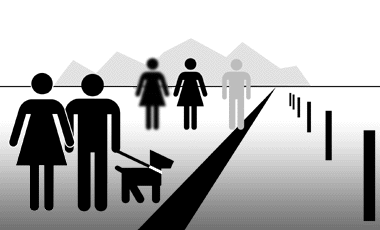


They are important visual depth cues in three dimensional spaces. These are the cues that are provided by both the eyes working together. The distant object appears to move slowly than the objects that are close.

Relative height: We perceive large objects to be closer to us and smaller objects to be farther away.Therefore, if we see details of an object we perceive it closer.

For example, on a hazy day a distant mountain would appear far away than on a clear day, because haze blurs the fine details. Clearness: The more clear the object the nearer it seems.The object that is completely visible seems to be nearer and the object that is partially visible seems to be farther away. Interposition or overlapping: This monocular cue occurs when one object covers the other.It says that the distant between two objects far away appear to be smaller than what the distance actually is. Linear perspective reflects this phenomena. You would see that the rail track become smaller and smaller, until there is a point where they meet each other. Linear perspective: Imagine you are standing between the rail tracks and looking in the distance.Visual perception Perception obtained through the sense of vision.The following are the monocular cues that help us in judging the depth and distance in two-dimensional surfaces: The effect is then of extremely short duration (less than 200 ms). exposure of 40 ms duration masked by another stimulus), unconsciously arouse perception. subliminal) may, in rare circumstances (e.g. Subliminal perception Stimuli below the threshold of sensation (i.e. Loss of light perception represents blindness. (LP) Term used to indicate a barely seeing eye that can just see light but not the form of objects. See stereoscopic visual acuity visual binocular cliff cell moon illusion aerial perspective linear perspective relief Ames room leaf room stereopsis.ĭermo-optical perception See extrasensory perception.Įxtrasensory perception Perception obtained by means other than through the ordinary senses as, for example, telepathy (mind reading) or reading by moving a finger over a printed text ( dermo-optical perception). Depth perception is more precise in binocular vision but is possible in monocular vision using the following cues: interposition (superposition), relative position, relative size, linear perspective, textural gradient, aerial perspective, light and shade, shadow and motion parallax (Fig. There are also many other contributing factors, such as the characteristics of the stimulus (called cues), binocular parallax and, to a smaller extent, the muscular proprioceptive information due to the efforts of accommodation and convergence. Most important is the existence on the two retinae of different images of the same object (called binocular disparity or retinal disparity). Many factors contribute to depth perception. Our ability to judge the latter is much more precise than for the former. See sensation visual integration.Īnorthoscopic perception See anorthoscope.īinocular perception Perception obtained through simultaneous use of both eyes.ĭepth perception Perception of the distance of an object from the observer ( absolute distance) or of the distance between two objects ( relative distance). Thus one recognizes the shape, colour, location and differentiation of an object from its background. The mental process of recognizing and interpreting an object through one or more of the senses stimulated by a physical object.


 0 kommentar(er)
0 kommentar(er)
